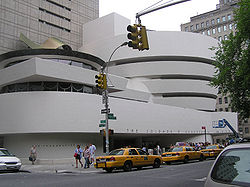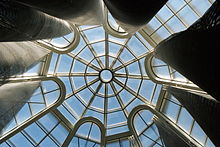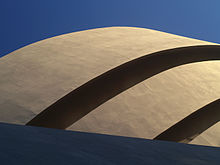- Solomon R. Guggenheim Museum
-
For other uses, see Guggenheim Museum.
Coordinates: 40°46′59″N 73°57′32″W / 40.782975°N 73.958992°W
Solomon R. Guggenheim Museum 
Viewed from Fifth AvenueEstablished 1937 Location Upper East Side, New York City, United States Type Art museum Director Richard Armstrong Public transit access 86th Street (IRT Lexington Avenue Line) Website Location: 1071 Fifth Ave., New York, New York Area: less than one acre Built: 1959 Architect: Wright, Frank Lloyd; Cohen, George Architectural style: Modern Movement NRHP Reference#: 05000443[1] Added to NRHP: May 19, 2005 The Solomon R. Guggenheim Museum (often referred to as "The Guggenheim") is a well-known museum located on the Upper East Side of Manhattan in New York City, United States. It is the permanent home to a renowned collection of Impressionist, Post-Impressionist, early Modern, and contemporary art and also features special exhibitions throughout the year. Designed by Frank Lloyd Wright, it is one of the 20th century's most important architectural landmarks. The museum opened on October 21, 1959, and was the second museum opened by the Solomon R. Guggenheim Foundation; from 2005 to 2008 it underwent an extensive renovation.
Contents
History
Solomon Guggenheim, guided by his art adviser and German painter Hilla Rebay, began to collect works by nonobjective artists in 1929. (For Rebay, the word "nonobjective" signified the spiritual dimensions of pure abstraction.) Guggenheim first began to show his collection in his apartment, and as the collection grew, he established The Solomon R. Guggenheim Foundation in 1937. Guggenheim and Rebay opened the foundation for the "promotion and encouragement and education in art and the enlightenment of the public." Chartered by the Board of Regents of New York State, the Foundation was endowed to operate one or more museums; Solomon Guggenheim was elected its first President and Rebay its Director.
In 1939, the Guggenheim Foundation's first museum, "The Museum of Non-Objective Painting", opened in rented quarters at 24 East Fifty-Fourth Street in New York and showcased art by early modernists such as Rudolf Bauer, Hilla Rebay, Wassily Kandinsky, Paul Klee and Piet Mondrian. During the life of Guggenheim's first museum, Guggenheim continued to add to his collection, acquiring paintings by Marc Chagall, Robert Delaunay, Fernand Léger, Amedeo Modigliani and Pablo Picasso. The collection quickly outgrew its original space, so in 1943, Rebay and Guggenheim wrote a letter to Frank Lloyd Wright pleading him to design a permanent structure for the collection. It took Wright 15 years, 700 sketches, and six sets of working drawings to create the museum. From 1943 to early 1944, Wright produced four different sketches for the initial design, due to the chosen site and job importance. One of the plans (scheme C) was a hexagonal shape as opposed to the other three circular sketches. It was the only design of the four to have level floors for the galleries without the use of one ramp continuing around the building. While Wright was designing the museum Rebay was searching for sites where the museum would reside. Where the museum now stands was its original chosen site by Rebay which is at the corners of 89th Street and Fifth Avenue (overlooking Central Park). On October 21, 1959, ten years after the death of Solomon Guggenheim and six months after the death of Frank Lloyd Wright the Museum opened its doors for the first time to the general public.[2]
The distinctive building, Wright's last major work, instantly polarized architecture critics upon completion,[3] though today it is widely revered.[4] From the street, the building looks like a white ribbon curled into a cylindrical stack, slightly wider at the top than the bottom. Its appearance is in sharp contrast to the more typically boxy Manhattan buildings that surround it, a fact relished by Wright who claimed that his museum would make the nearby Metropolitan Museum of Art "look like a Protestant barn."[3]
Internally, the viewing gallery forms a gentle helical spiral from the main level up to the top of the building. Paintings are displayed along the walls of the spiral and also in exhibition space found at annex levels along the way.
Most of the criticism of the building has focused on the idea that it overshadows the artworks displayed within, and that it is particularly difficult to properly hang paintings in the shallow windowless exhibition niches that surround the central spiral. The walls of the niches are neither vertical nor flat (most are gently concave), meaning that canvasses must be mounted proud of the wall's surface. Paintings hung slanted back would appear "as on the artist's easel". The limited space within the niches means that sculptures are generally relegated to plinths amid the main spiral walkway itself. Prior to its opening, twenty-one artists, including Willem de Kooning and Robert Motherwell, signed a letter protesting the display of their work in such a space.[3]
 A 1966 U.S. postage stamp honoring Frank Lloyd Wright, with the Guggenheim visible in the background.
A 1966 U.S. postage stamp honoring Frank Lloyd Wright, with the Guggenheim visible in the background.
In 1992, the building was supplemented by an adjoining rectangular tower, taller than the original spiral, designed by the architectural firm of Gwathmey Siegel & Associates Architects.[5] By that point, the building had become iconic enough that this augmentation of Wright's original design was itself controversial.
In October 2005, Lisa Dennison, a longtime Guggenheim curator, was appointed director of the Solomon R. Guggenheim Museum in New York. Dennison resigned in July 2007 to work at the auction house Sotheby's.[6]
From October 2005 to February 2008, Thomas Krens remained director of the Solomon R. Guggenheim Foundation, having won a decisive victory over billionaire philanthropist and board member Peter Lewis. A significant contributor to the Guggenheim Foundation, Lewis resigned in 2005 in a dispute with the board over the direction and leadership of the Foundation. Despite this, Krens and Lewis nevertheless continue to agree in describing the building itself as "the most important piece of art in the collection."[7]
In February 2008, Krens stepped down as the Director of the Guggenheim Foundation, but remains an advisor to the Guggenheim's international expansion projects. The search for a new Director, who will head both the New York museum and the Foundation was recently completed with the Board's appointment of Richard Armstrong—formerly director of Pittsburgh's Carnegie Museum of Art—as its fifth director.[8]
Exterior restoration
Between September 2005 and July 2008, the Guggenheim Museum underwent a significant exterior restoration.
In the first phase of this project, a team of restoration architects, structural engineers, and architectural conservators worked together to create a comprehensive assessment of the building's current condition that determined the structure to be fundamentally sound. This initial condition assessment included:
- the removal of 11 coats of paint from the original surface, revealing hundreds of cracks caused over the years, primarily from seasonal temperature fluctuations[9]
- detailed monitoring of the movement of selected cracks over 17 months
- impact-echo technology, in which sound waves are sent into the concrete and the rebound is measured in order to locate voids within the walls
- extensive laser surveys of the exterior and interior surfaces, believed to be the largest laser model ever compiled
- core drilling to gather samples of the original concrete and other construction materials
- testing of potential repair materials.[10]
Much of the interior of the building was restored during the 1992 renovation and addition by Gwathmey Siegel and Associates Architects. The 2005–2008 restoration primarily addresses the exterior of the original building and the infrastructure. This includes the skylights, windows, doors, concrete and gunite facades and exterior sidewalk, as well as the climate-control. The goal will be to preserve as much significant historical fabric of the Solomon R. Guggenheim Museum as possible, while accomplishing necessary repairs and attaining a suitable environment for the building's continuing use as a museum.[11]
On September 22, 2008, friends and supporters of the Guggenheim gathered in New York to mark the completion of the 3-year renovation of the Frank Lloyd Wright-designed Museum. New York City Mayor Michael R. Bloomberg officiated at the celebration that culminated, just after sunset, with the premiere of artist Jenny Holzer's tribute For the Guggenheim,[12] a work commissioned in honor of Peter B. Lewis, who was a major benefactor in the Museum restoration project. Other supporters of the $29 million dollar restoration included the Board of Trustees of the Solomon R. Guggenheim Foundation, and the Department of Cultural Affairs of the City of New York. Additional support was provided by the State of New York and MAPEI Corporation.[13] The museum was registered as a National Historic Landmark on October 6, 2008.[14]
Significance in popular culture
The building has become a cultural icon and can be seen widely throughout popular culture. It is featured in Matthew Barney's The Cremaster Cycle, Bye Bye Birdie, Men in Black, When in Rome, Downtown 81, Ugly Betty and prominently in The International, where a major shootout occurs in the museum. (In fact, a life-size replica of the museum was built for this scene.[15]) The New Yorker has included the museum multiple times on its cover and cartoons.
Works and Process
Works and Process is a series of performances at the Guggenheim begun in 1984.[16] The first season consisted of Philip Glass with Christopher Keene on Akhnaten and Steve Reich and Michael Tilson Thomas on The Desert Music.
See also
- List of museums and cultural institutions in New York City
- Museum Mile
- V. C. Morris Gift Shop, site of ramp prototype
- Solomon R. Guggenheim
- Guggenheim Museum (disambiguation) (a list of all museums founded by the Guggenheim Foundation)
- Guggenheim family
- Thomas Krens
- The Art of the Motorcycle
References
- ^ "National Register Information System". National Register of Historic Places. National Park Service. 2009-03-13. http://nrhp.focus.nps.gov/natreg/docs/All_Data.html.
- ^ "Guggenheim Foundation History". The Solomon R. Guggenheim Foundation. 2010. http://www.guggenheim.org/guggenheim-foundation/history. Retrieved 8 july 2010.
- ^ a b c "Last Monument," Time. November 2, 1959.
- ^ "The Wright Stuff," USA Today (Weekend). November 6, 1998
- ^ Gwathmey Siegel web site: Overview of firm's history, projects, etc.
- ^ Vogel, Carol. "Director of Guggenheim Resigns to Join Sotheby’s," New York Times. July 31, 2007.
- ^ Vogel, Carol. "Guggenheim Museum Seeks to Restore Its Most Valuable Asset: Itself," New York Times. June 10, 2004.
- ^ Vogel, Carol. "Guggenheim Chooses a Curator, Not a Showman" New York Times. September 23, 2008
- ^ Haeyoun Park."Face-lift for an Aging Museum," New York Times. April 16, 2007. – graphic illustration of cracking.
- ^ Pogrebin, Robin. "The Restorers' Art of the Invisible," New York Times. September 10, 2007, pp. E1-5.
- ^ Guggenheim Museum web site: click link to podcast about restoration (10 MB, audio only, 8 min 45 sec)
- ^ Ignacio Villarreal. "artdaily.org "Guggenheim Marks Completion of Restoration With First Public Viewing of Work by Artist Jenny Holzer"". Artdaily.com. http://www.artdaily.com/index.asp?int_sec=2&int_new=26285. Retrieved 2009-05-08.
- ^ Guggenheim Museum web site: click link to streaming video, broadband only[dead link]
- ^ "National Register of Historic Places; New Listings October 6 – October 10, 2008 (Building #05000443)". Nps.gov. 2008-10-17. http://www.nps.gov/history/nr/listings/20081017.HTM. Retrieved 2009-05-08.
- ^ Susan Shineberg (2007-11-10). "Wall-to-wall culture". The Age. http://www.theage.com.au/news/arts/walltowall-culture/2007/11/09/1194329483873.html?page=fullpage#contentSwap2. Retrieved 2007-12-10.
- ^ Works and Process
External links
- Official website
- Gwathmey Siegel Solomon R. Guggenheim Museum Renovation and Addition project page
- Architectural Review
- Art of the Motorcycle Exhibit
- New York Academy of Sciences Podcast about Imageless Exhibit
- Happy 50th Birthday, Guggenheim – slideshow by Life magazine
- 50 Facts on Guggenheim's 50th – Daily News archives
- The Guggenheim 50th Birthday Party
Categories:- Buildings and structures on the National Register of Historic Places in Manhattan
- Buildings and structures completed in 1959
- Frank Lloyd Wright buildings
- Modernist architecture in New York
- Guggenheim family
- National Historic Landmarks in New York City
- Fifth Avenue (Manhattan)
- Museums established in 1937
- Guggenheim Museum
- Modern art museums in the United States
- Art museums in New York
- Museums in Manhattan
- Rotundas
Wikimedia Foundation. 2010.







